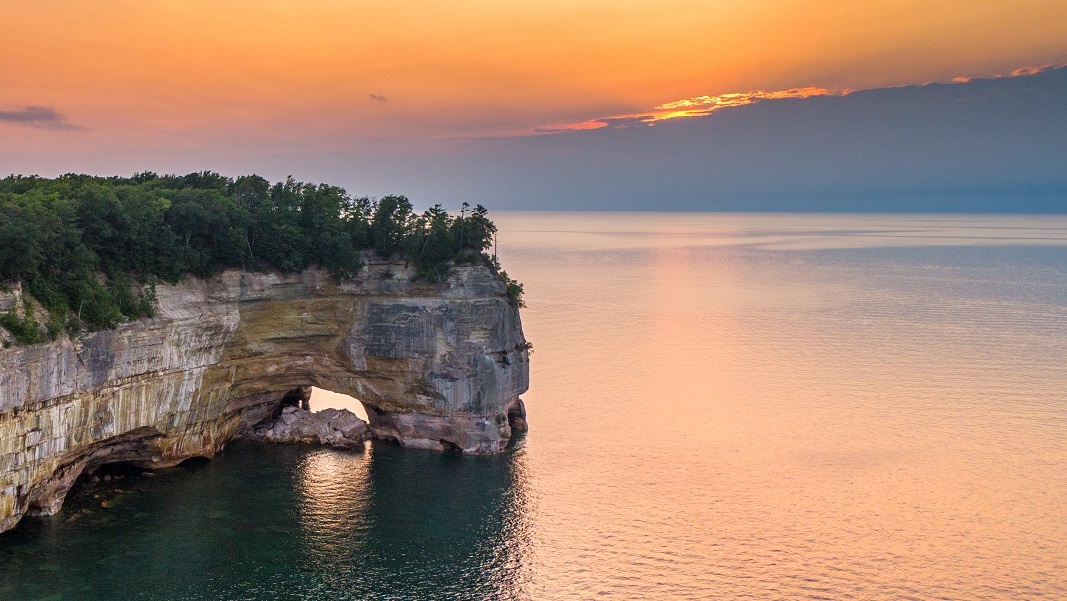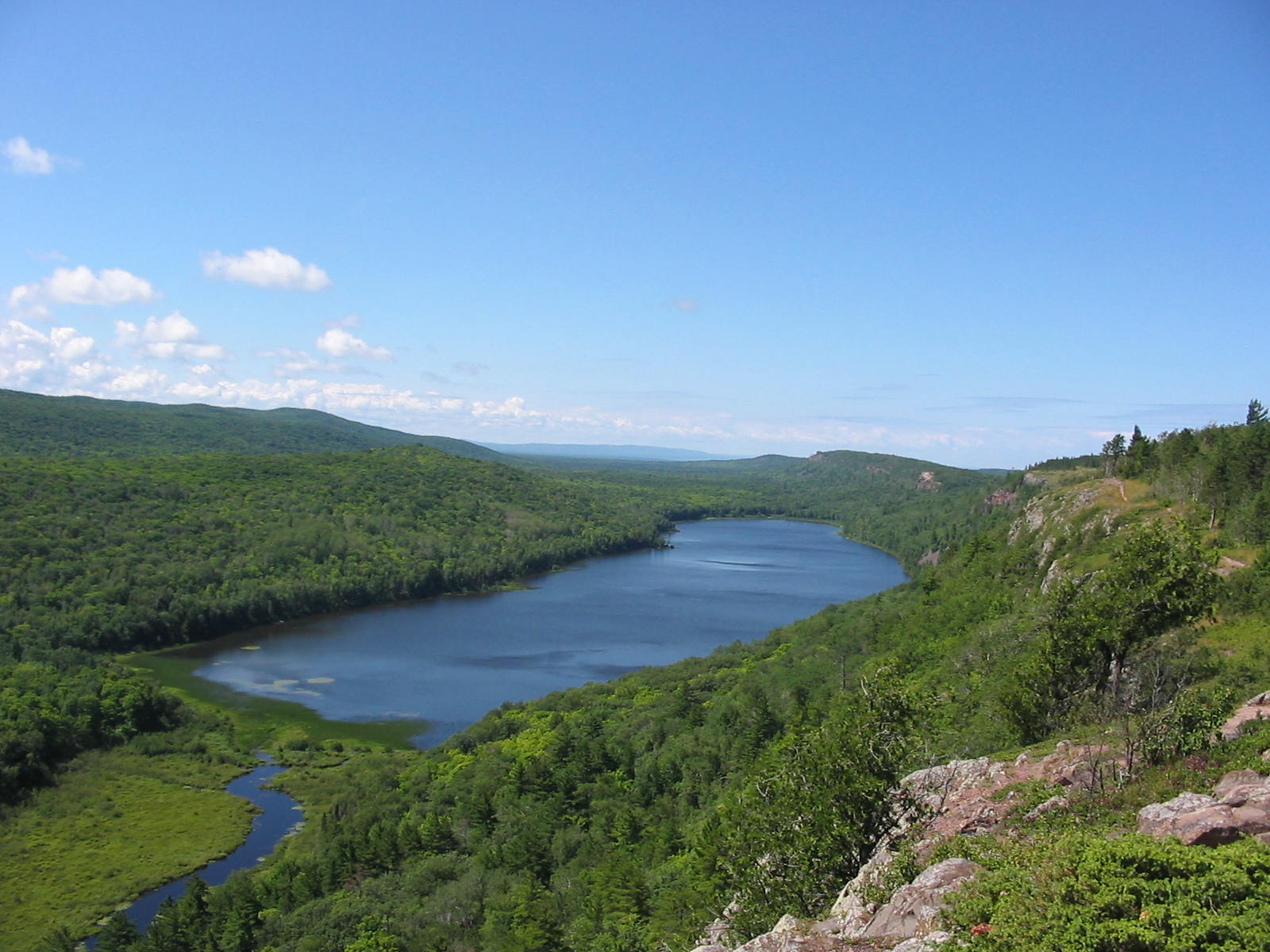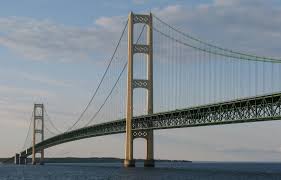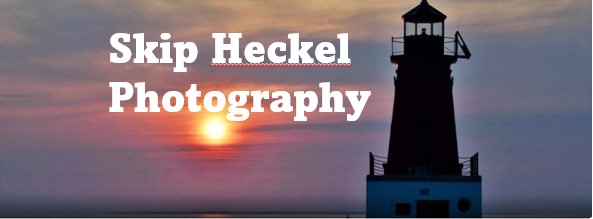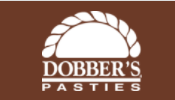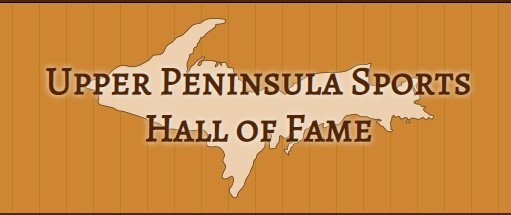MICHIGAN'S UPPER PENINSULA
By Mike Miller, July 18, 2022
Yooper Secret's goal is to be an entertaining resource for people wanting to visit Michigan's Upper Peninsula and for people who live here now or have lived here in the past.
It is a lot of fun to share memories of the way it used to be, and this site can handle visitor comments. We look forward to sharing your knowledge, memories, and secret places.
In addition to its natural beauty, a large part of the Upper Peninsula's charm is its people. As recently as a century ago, 75% of the people in the U.P. were foreign born.
This has resulted in a unique melting pot of Americans with strong traditions and memories of the old country passed down through the generations.
In 1920 the population of the Upper Peninsula was 322,566.
In 2020 the population of the Upper Peninsula was 311,611.
This astounding demographic fact alone makes the Upper Peninsula a unique place. Most places in the world are getting crowded. There is still "elbow room" in the U.P. and Yoopers want it to stay that way.
HISTORY OF MICHIGAN'S UPPER PENINSULA
Michigan became a state in 1837. Before then it was known as part of the Northwest Territory and then the Michigan Territory.
It's the only state with two peninsulas and the Upper Peninsula bounced around among several territories, including Wisconsin and Ohio, until it was finally granted to the new state of Michigan.
Henry Wadsworth Longfellow wrote about the Upper Peninsula in his 1855 epic poem "The Song of Hiawatha." The poem relates the fictional adventures of Native Americans along Lake Superior. It begins:
On the shores of Gitche Gumee,
Of the shining Big-Sea-Water,
Stood Nokomis, the old woman,
Pointing with her finger westward,
O'er the water pointing westward,
To the purple clouds of sunset.
The Upper Peninsula shares about 200 miles of its border with Wisconsin.
Many Yoopers identify more with the Badger state than they do with the Michigan mitten they are connected to only by the Mackinac Bridge.
 Map of United States Showing Michigan's Lower and Upper Peninsulas
Map of United States Showing Michigan's Lower and Upper PeninsulasThe Upper Peninsula was actually granted to Michigan to settle a dispute with Ohio over the area now known as Toledo. You can check out the Toledo War to learn more.
So Michigan got the Upper Peninsula and Ohio got Toledo. It took awhile for people to figure out who got the better deal.
The Upper Peninsula was described in a government report as a
"sterile region on the shores of Lake Superior destined by
soil and climate to remain forever a wilderness."
Things took a sudden turn in Michigan's favor in the 1840s when the Upper Peninsula was soon discovered to have vast deposits of copper and iron ore.
Most of the copper mines were in the western part of the Upper Peninsula; the iron mines were in the central region.
The mines created an economic boom in the U.P. that produced more wealth than the California Gold Rush had done during the era of the "Forty Niners."
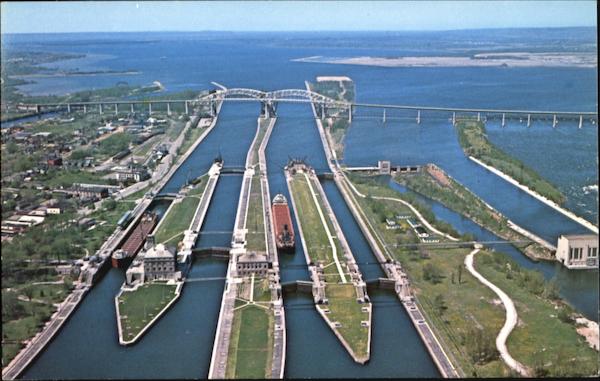 The Soo Locks in Sault Ste. Marie, Michigan
The Soo Locks in Sault Ste. Marie, MichiganThe Soo Locks between Lakes Superior and Huron were built in 1855 and shipping from the Upper Peninsula was made far more efficient by avoiding the rapids on the St. Mary's River.
The city of Sault Ste Marie is named for an ancient French word that means waterfall.
Yoopers and most others simply call Sault Ste. Marie The Soo. The town across the locks in Canada has the same name.
Huge iron ore docks were constructed in Marquette in 1859. These docks were used to load ore from the mines onto ships for transport to steel mills along the Great Lakes.
The mines on the iron range needed workers, so thousands of immigrants arrived from Italy, Sweden, and other European countries to fill the needs.
This boom in copper also created a huge influx of immigrants moving to the area to work in the mines of the western Upper Peninsula, a region that became known as the "Copper Country."
The first group of copper miners came from Cornwall in England where many laborers had extensive mining experience.
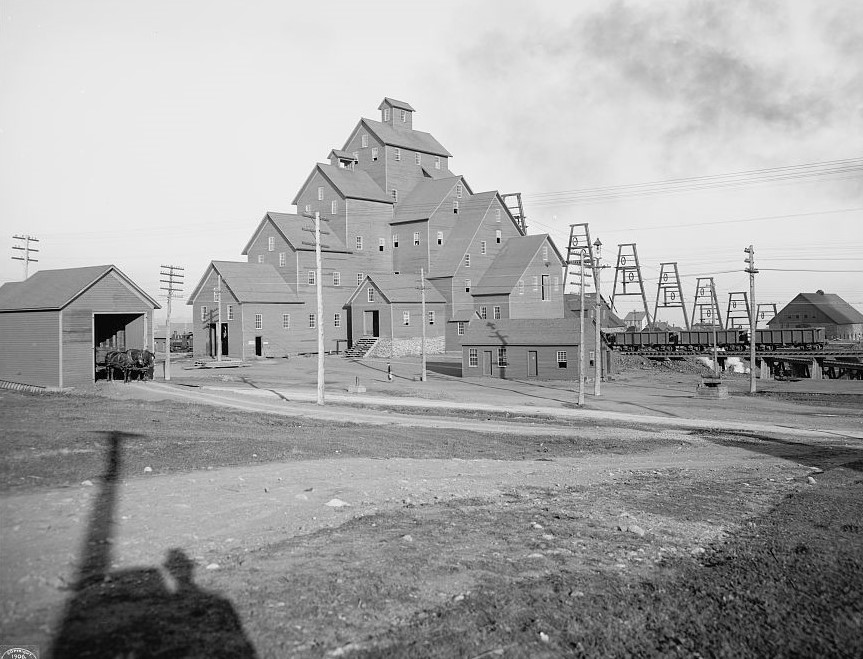 Quincy Copper Mine in Hancock, Michigan
Quincy Copper Mine in Hancock, MichiganThese Cornish miners brought a meat pie to work with them called a pasty. At lunch time they would heat up the pasty with their acetylene head lamps and have a nice hot meal.
The next large groups of immigrants to the Copper Country came from Finland, Ireland, Germany, and French Canada.
By the 1860s the Upper Peninsula was supplying 90% of the United States copper production.
KEWEENAW PENINSULA AND ISLE ROYALE
Isle Royale is an island in Keweenaw County in Lake Superior. It is surrounded by 450 smaller islands and the entire group comprises Isle Royale National Park.
Because of its remoteness, it is the least visited national park in the lower 48 United States. The island can be reached only by seaplane, boat, private ferries, and a National Park Service ferry from Copper Harbor.
The island is a nature lover's paradise with an amazing assortment of wildlife, many of which have never seen a human being. You can camp on the island, hike, kayak, and just enjoy the remote solitude.
The Keweenaw Peninsula juts northward into Lake Superior north of Houghton-Hancock. It is famous for its record snowfalls, receiving an average of 270 inches of snow each year.
Yoopers today still love their pasties. Most of them have their favorite recipes. By the way, it is pronounced PASS-TEE.
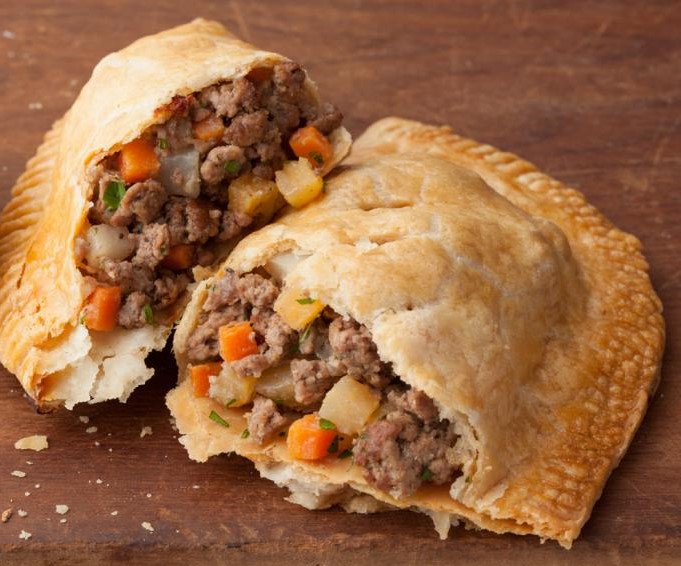 A Pasty
A PastyHere is an Upper Peninsula Pasty Recipe from TasteOfHome.com
2 cups shortening
2 cups boiling water
5 1/2 to 6 cups all purpose flour
2 teaspoons salt
6 medium red potatoes
2 small rutabagas
1 pound ground beef
1. In a large bowl, stir shortening and water until shortening is melted. Then gradually stir in the flour and salt until very soft dough is formed. Cover and refrigerate for 1 1/2 hours.
2.Cut potatoes and rutabagas into 1/8 inch or 1/4 inch cubes. Do not make cubes too large or they will not cook properly. Gently combine ground beef and pork; break into small crumbles. In a large bowl, combine potatoes, rutabagas, onions, meat mixture and seasonings.
1/2 pound ground pork
2 medium onions chopped in 1/4 in pcs
3 teaspoons salt
2 teaspoons pepper
2 teaspoons garlic powder
1/4 cup butter
Half & Half cream or lightly beaten egg
3. Divide dough into 12 equal portions. On a floured surface, roll out 1 portion at a time into an 8 inch circle. Mound 1-1/2 to 2 cups filling on half of each circle; dot with 1 teaspoon of butter. Moisten edges with water; carefully fold dough over filling and press edges with a fork to seal.
4. Place on ungreased baking sheets. Cut several slits in top of pasties. If desired, brush with cream or beaten egg. Bake at 350 degrees until golden brown, about one hour. Cool on wire racks. Serve hot or cold. Store in refrigerator.
Here is an excellent article that tells you about their 13 favorite pasty places in the U.P.
13 UP Pasties You Must Try On Your Next Visit
In the early 1900s more than 75% of the population of the Upper Peninsula were foreign born.
Here is another great article about UP Pasties:
The Pasty Trail: Road Trips to Great Pasties
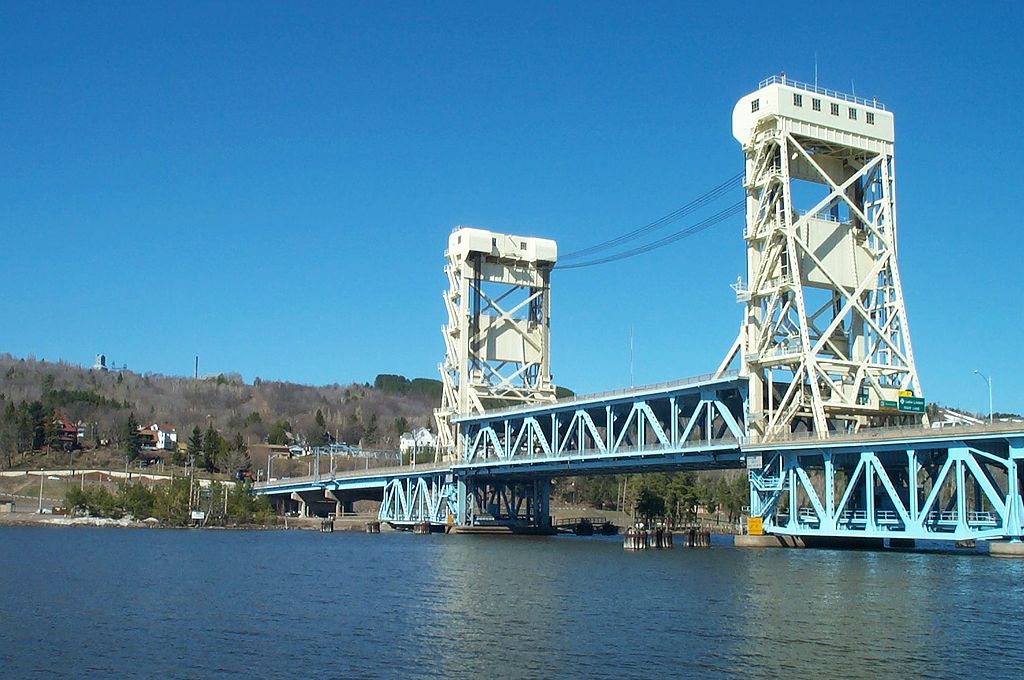 Portage Lake Lift Bridge, Houghton-Hancock
Portage Lake Lift Bridge, Houghton-HancockThe majority of the population of the Northwest Upper Peninsula around the copper mines were Finnish. A college was founded in 1896 in Hancock named Suomi College and Theological Seminary.
It has grown into the only private university in the Upper Peninsula and is now called Finlandia University.
The intensive mining in the U.P. also created a need for engineers, and this is how Michigan Technological University in Houghton came to be. In the early days we called it "Hougton Tech."
By the 1890s the Upper Peninsula was the largest supplier of iron ore in the country and continued to be so until the 1920s.
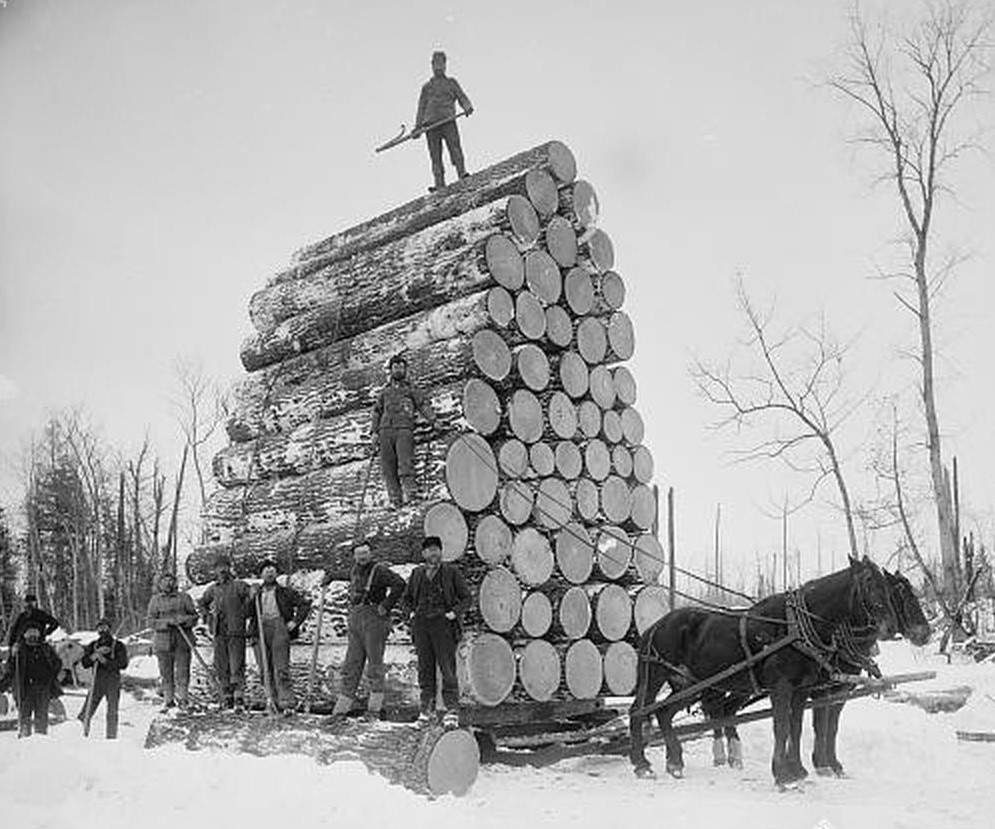 Michigan Timber, Library of Congress
Michigan Timber, Library of CongressThe other major industry in the Upper Peninsula was lumbering. The land was covered by millions of acres of a wide variety of trees. It is said that most of the buildings in Milwaukee and Chicago were built using timber from the Upper Peninsula.
The virgin trees were very large, and thousands of people worked cutting down trees, floating them down rivers to mills, working in the mills and other lumber support industries.
By the 1890s most of the prime Upper Peninsula forests were cut down to clear land for farms, build homes and businesses, ships, and the massive timber shoring for copper and iron ore mining and shipping operations.
Many of the sawmills were in Menominee at the mouth of the Menominee River where millions of logs were floated down over the years from the adjacent forests.
The town of Menominee at one time shipped out more milled lumber than any other city in the United States. Menominee also had a large sawmill machinery industry manufacturing saws, pulleys, lathes, and other automated tools.
When the forests were depleted of the large trees and only small brush remained, the 1870s saw many dangerous fires.
The most famous fire started in Peshtigo in 1871, a small Wisconsin town a few miles south of the Menominee River.
It spread literally like wildfire to the Upper Peninsula, northern Wisconsin, and even set flaming debris across Green Bay to Door Peninsula.
A museum in Peshtigo preserves the stories and artifacts of the horrible event.
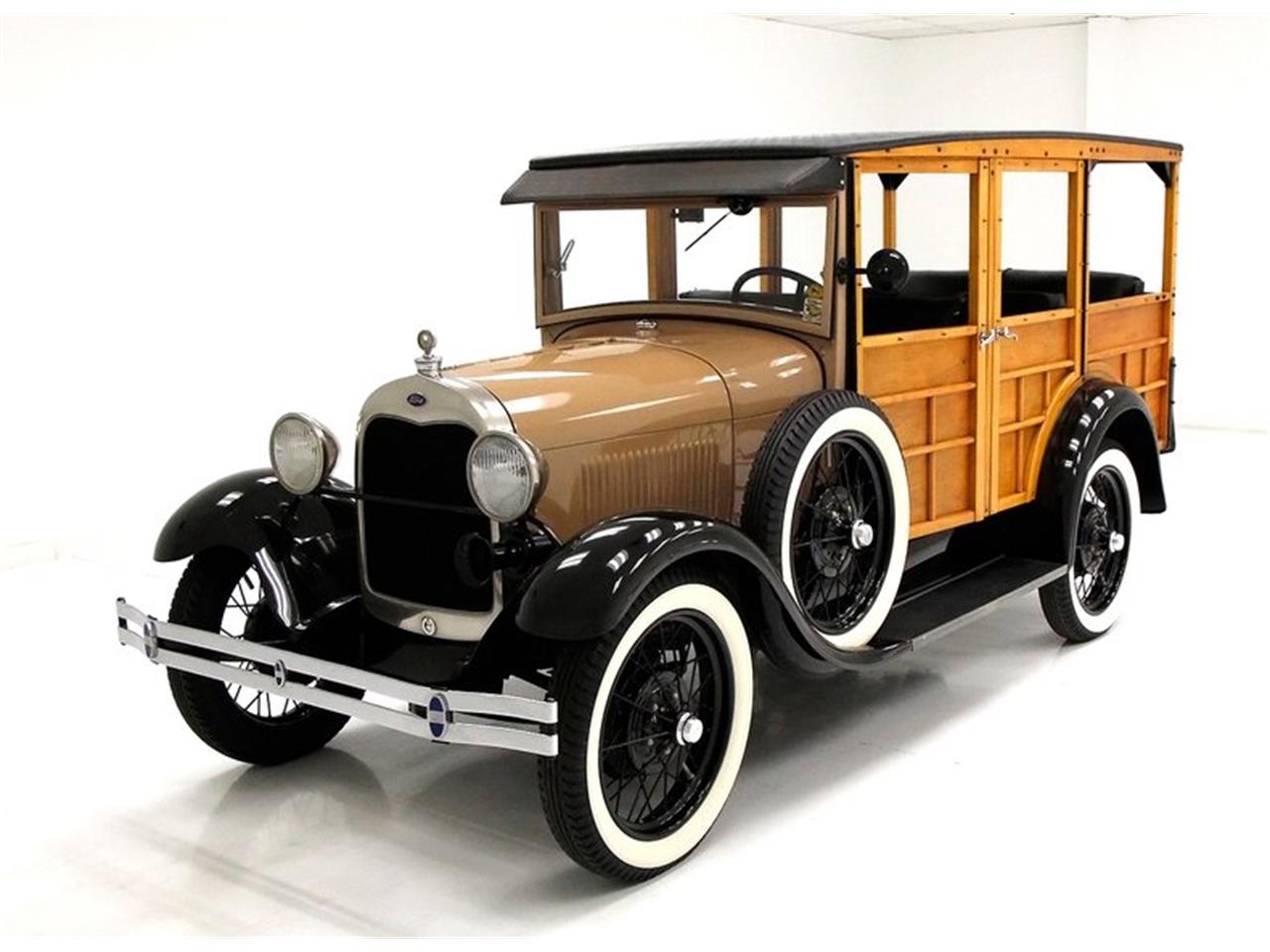 1929 Ford Woody
1929 Ford WoodyThe forests had been so plentiful that Henry Ford established the town of Kingsford and owned more than 500,000 acres in the Upper Peninsula to provide lumber for his cars.
The early Fords used as much as 100 board feet of hardwood per Model T, and station wagons used even more.
By the 1920s most of the timber was gone and the mines were not producing as much copper and iron ore.
Unlike other parts of the country where everybody leaves and you end up with ghost towns, many Yoopers chose to stay.
There are very few places in this country that have fewer people now than they did 100 years ago. The population has remained stable for a number of reasons, the most important one being the depletion of its natural resources.
Some people stay in the area but many leave for larger cities like Green Bay, Milwaukee, and Chicago. That's where the jobs are.
The Upper Peninsula was a boom region, like California had been earlier in the Gold Rush, like Texas and Oklahoma during the era of big oil strikes.
Like most booms, this one had to come to an end.
MICHIGAN'S UPPER PENINSULA TODAY
Natives of the Upper Peninsula have a strong regional identity. This is one reason the name "Yooper" caught on so quickly. This strong feeling of belonging to a place has resulted in several proposals over the years to make it a separate state.
 Mackinac Bridge in Winter
Mackinac Bridge in WinterThe idea was to create a 51st State of Superior. It never caught on because the U.P. has very little political clout in the bigger lower peninsula of Michigan where the laws are made.
Political clout is based on numbers. While the Upper Peninsula has 29% of the land area of Michigan, it only has 3% of the state's total population.
The City of Detroit has twice as many people than the entire Upper Peninsula. The politicians favor helping out places with the most votes.
A century ago the Upper Peninsula had a population that was about 10% of the state's total and created a lot of wealth.
Today it shares Michigan's 1st Congressional District with 16 other counties in the northern part of lower Michigan who don't have a lot in common with the Upper Peninsula.
Many Yoopers like to refer to people who live in downstate Michigan as "fudgies" or "trolls". The fudgie reference is about Mackinac Island where fudge is made for the tourists and where the Upper Peninsula ends and the Lower Peninsula begins.
The troll thing is because Lower Michiganders live below the bridge, in this case the Mackinac Bridge that connects the two Michigan peninsulas across the Straits of Mackinac.
Mackinac Island is a resort destination on northern Lake Huron between Michigan's Upper and Lower Peninsulas. It can only be reached by plane or boat.
Ferry service runs from both peninsulas to the island. Fort Mackinac was founded in 1780 and is among many things you can enjoy on the island. The Grand Hotel is one of the largest and most historic hotels in the country.
Michiganders pronounce its name MACK-IN-AWE.
The small town on the northern lower peninsula near the Mackinac Bridge just goes ahead and spells itself MACKINAW CITY. Problem solved.
Both of these names derive from MICHILIMACKINAC, the name the early Native Americans gave to the entire area.
Most of the people in Upper Peninsula Michigan live in small towns or in the country.
The largest city by population is Marquette, on the shore of Lake Superior. It is a college town, home to Northern Michigan University.
Sault Ste. Marie - The Soo - is next and is where the famous Soo Locks are located that facilitates ship transportation from Lake Superior to the lower Great Lakes.
The Edmund Fitzgerald was on Lake Superior heading for The Soo when it got caught in a storm and sank in November 1975. The Canadian songwriter and singer Gordon Lightfoot memorialized it in his classic "Wreck of the Edmund Fitzgerald."
"The legend lives on from the Chippewa on down
Of the big lake they called Gitche Gumee
The lake, it is said, never gives up her dead
When the skies of November turn gloomy ...."
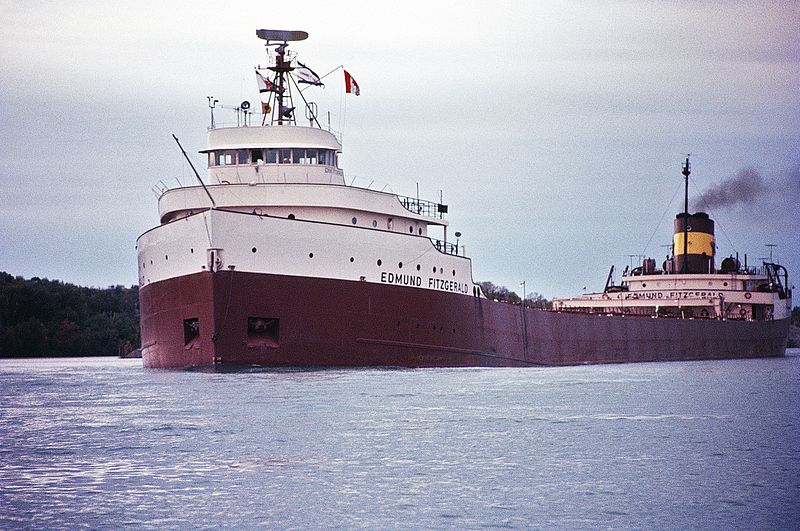 S. S. Edmund Fitzgerald
S. S. Edmund FitzgeraldThe Great Lakes Shipwreck Museum in Whitefish Point is one of the best places to learn about the Fitzgerald and other historical milestones and exhibits in the maritime museum.
Other cities in addition to Marquette and the Soo include Escanaba, Menominee, Houghton, Hancock, St. Ignace, and Iron Mountain.
We have a list of the "major" cities in the Upper Peninsula on a separate page of this website.
THE UPPER PENSINSULA HAS MANY LARGE FORESTS
The Upper Peninsula is heavily forested with trees grown back after the frantic lumber boom of the 19th and 20th centuries. You can drive for miles through state and national forests and rarely see another car.
The Hiawatha National Forest in the central part of the U.P. has 894,836 acres. The Ottawa National Forest in the western U.P. has 993,010 acres.
There are also numerous state forests located all over the Upper Peninsula.
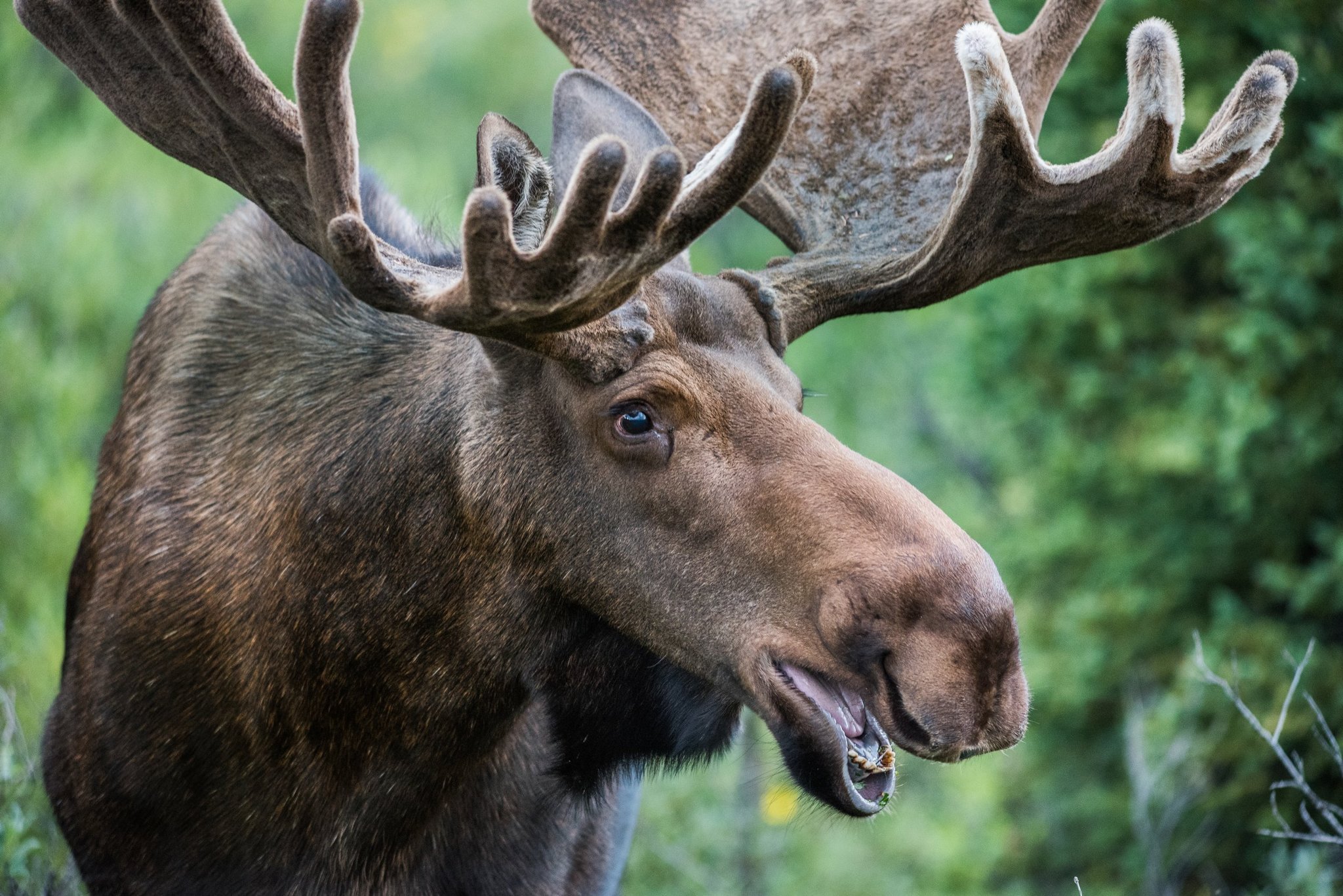 An Upper Peninsula Moose
An Upper Peninsula MooseThe Upper Peninsula offers a friendly home to an amazing amount of wildlife.
You may see elk, deer, moose, wolves, coyotes, foxes, bears, bobcats, eagles, hawks, owls, and just about any other kind of small animal that can survive the severe winters.

Yoopers are not the only ones who love the Upper Peninsula.
Plenty of little critters are also fond of the place, especially mosquitoes, black flies, and deer flies in the spring and summer months.
In the southern U.P. down near Menominee they sometimes have swarms of lake flies also known as Green Bay Flies. They don't bite, but can make a mess of your car.
As a result of the Upper Peninsula being surrounded by Lake Superior on one side and Lake Michigan on the other, heavy snowfall is a fact of life.
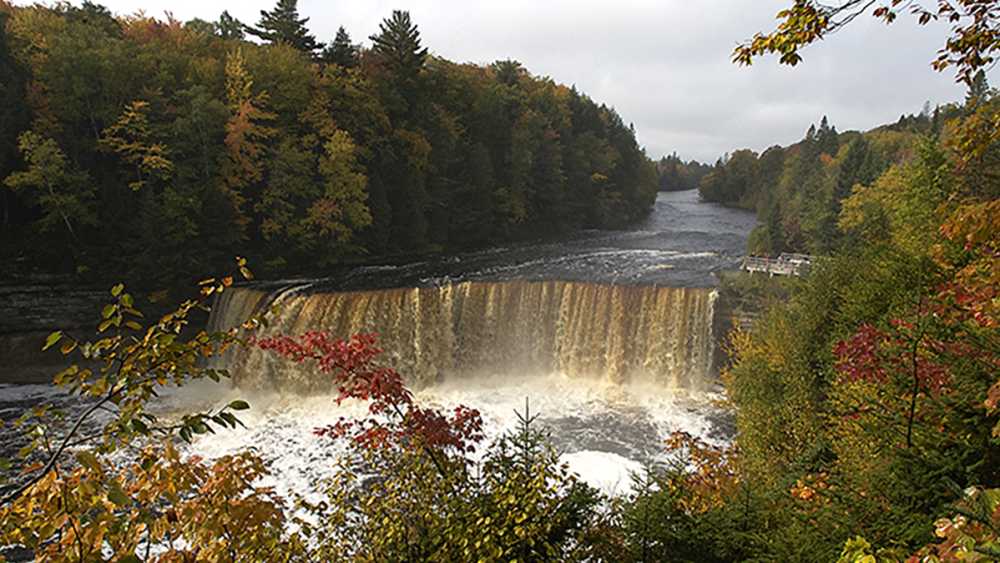 Tahquamenon Falls
Tahquamenon FallsThe Upper Peninsula has more than 300 waterfalls that get fed by the melting snow in spring and rain in summer. Most are small falls, and almost all require you to take a pretty good hike to see them.
Tahquamenon Falls is probably the most beautiful and most photographed waterfall in the Upper Peninsula. It is located in Tahquamenon Falls State Park.
 A Farm on Michigan's Upper Peninsula
A Farm on Michigan's Upper PeninsulaThis is not good farming country because of the soil types, short growing season, and long distances to major markets. A farmer has to work very hard to make a living, but a fair number of them do.
Many of the hardworking farm boys become stars on their local high school football and basketball teams. They do not have to work hard to get in shape; they already are.
MICHIGAN'S UPPER PENINSULA AUTUMN AND WINTER
Autumn in the Upper Peninsula of Michigan is an amazing array of fall colors even more spectacular than those you might see in the Smoky Mountains or Vermont.
The leaves start changing early up here and leaf peepers have to keep alert as to the timing of each particular year. The Upper Peninsula is one of the great places for road trips to enjoy the autumn sights.
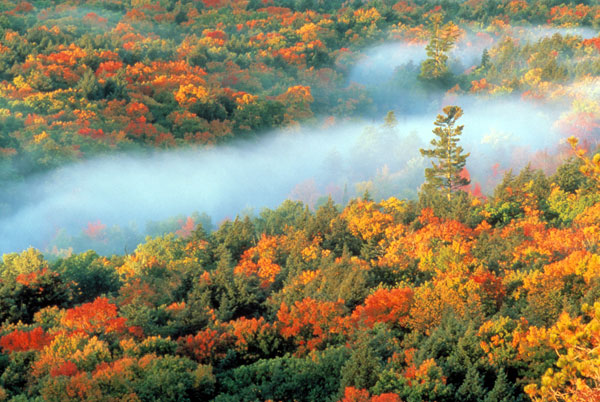 Autumn Leaves in Michigan's Upper Peninsula
Autumn Leaves in Michigan's Upper PeninsulaDeer hunting season in the Upper Peninsula is a rite of passage for many young boys who learn the art from their fathers.
A visitor to the U.P. might hear somebody refer to a "turdy poiner." He will learn it's not a potty mouth term. It simply means a "thirty pointer" which is a deer with a mighty big rack of horns.
A humorous look at the hunting culture is in Jeff Daniel's play written in 2001, "Escanaba in da Moonlight."
It was also made into a film of the same name.
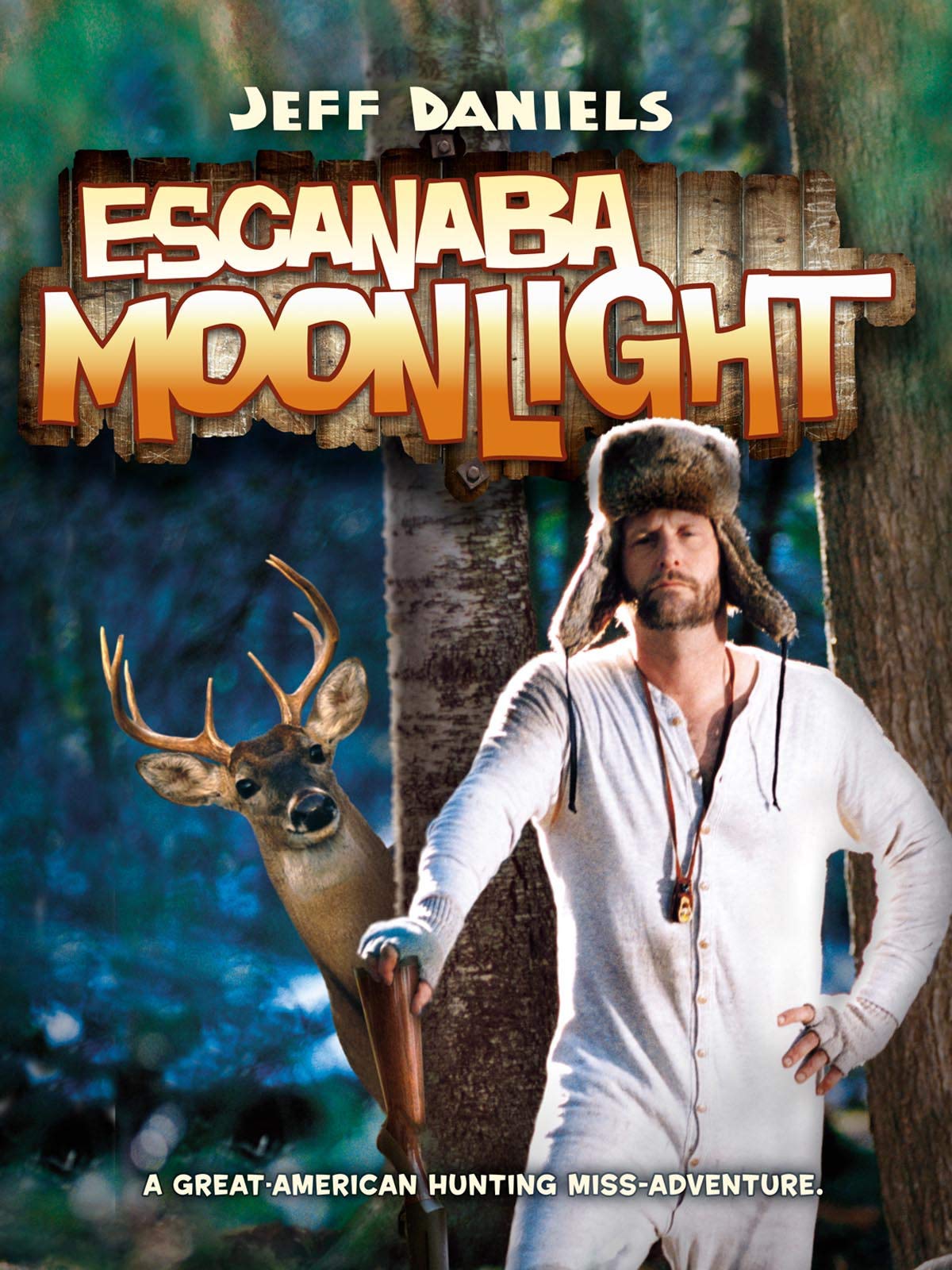
Some references made in the film are alien to anybody not familiar with the Upper Peninsula and Yooper terms.
Some examples are pasties, Leinenkugel Beer, Mackinac Island Fudge, the Superior State, Pictured Rocks National Seashore, euchre (a card game) and M-35, a popular road from Menominee to Escanaba along the shore of Green Bay.
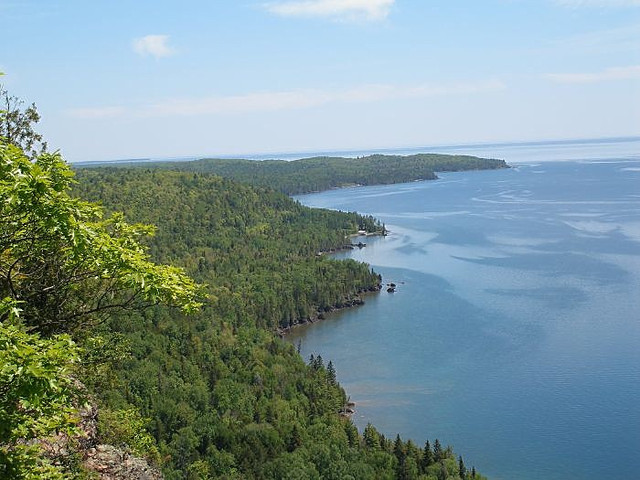 Lake Superior in Summer
Lake Superior in SummerAnother example of what Yoopers love about autumn is the beginning of football season. It is an important sport at almost all high schools.
Most Yoopers are fans of the Green Bay Packers and consider their home land to be part of "Packer Land."
My football coach at Menominee High School was Ken Radick. He went to Marquette University and played for the Packers in the 1930s.
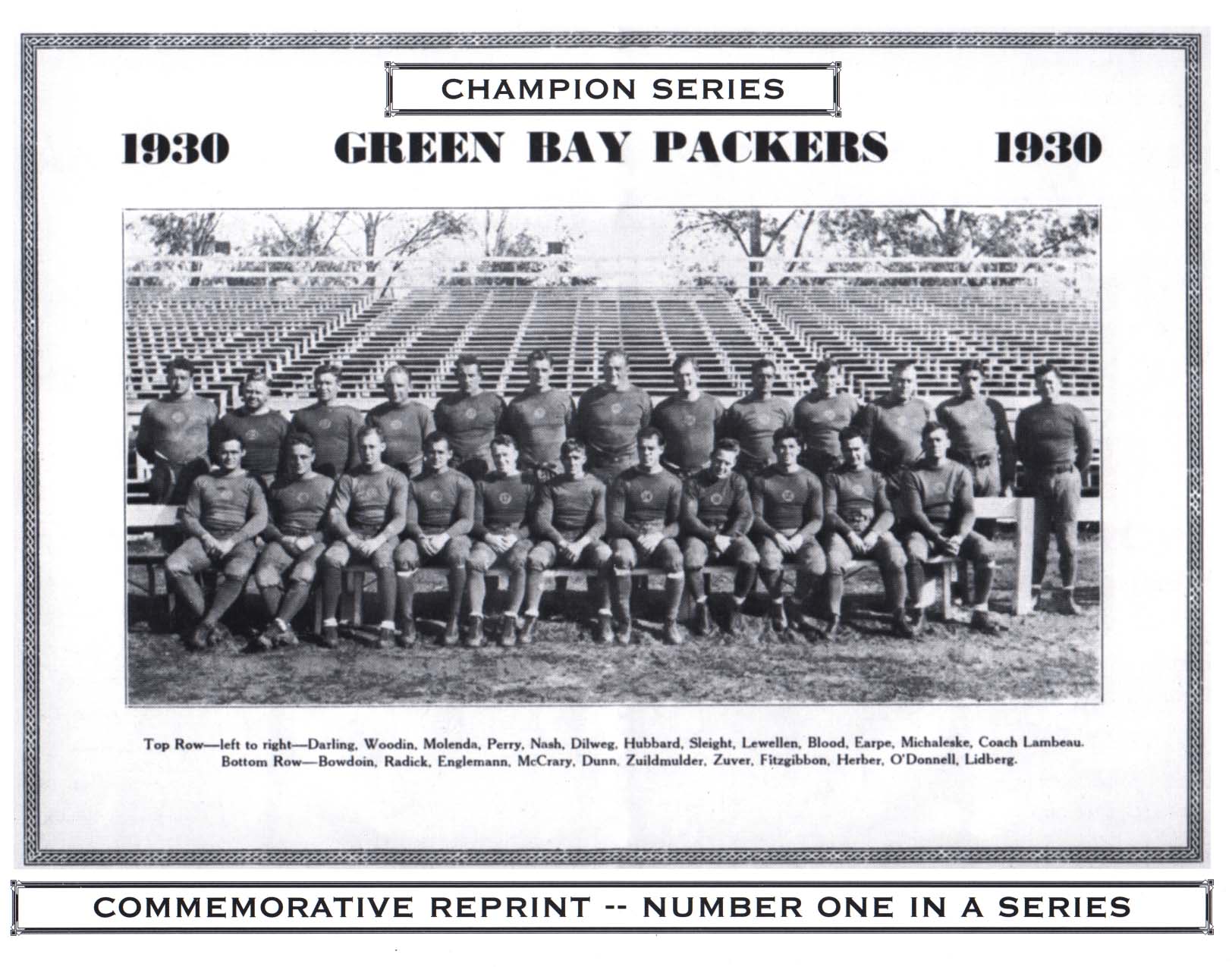 1930 Green Bay Packers Football Team
1930 Green Bay Packers Football TeamKen Radick is on the first row second from the left.
Yooper's love for the Packers can be fanatic, which is why they call them fans.
I heard a story a couple of years ago about a fan who died of a heart attack while in Lambeau Field watching the Packers play.
He was buried wearing his Green Bay packer jersey in a green and gold casket. His six pallbearers all wore green and gold sweatshirts.
To be fair, there also a few Detroit Lions fans in the Upper Peninsula counties near the Mackinac Bridge.
Sad to say there are even some Minnesota Viking fans in the far western hinterlands of the U.P. not far from Duluth, Minnesota.
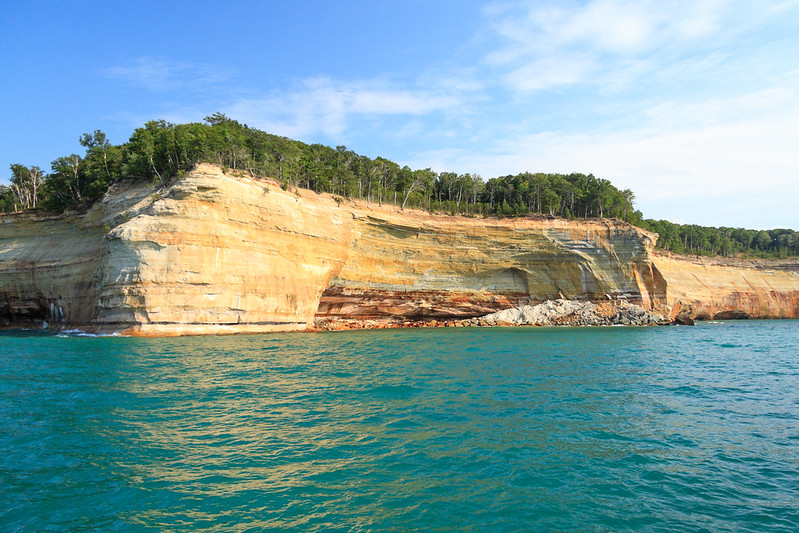 Pictured Rocks National Lakeshore near Munising
Pictured Rocks National Lakeshore near MunisingPictured Rocks National Lakeshore near Munising is a dramatically long bluff of many different colors and layers.
The Pictured Rocks are from 50 to 200 feet high straight up from Lake Superior and extend 15 miles along the 42 mile length of the National Seashore.
Some of the most beautiful shorelines in the country are on Lake Superior.
Not all Yoopers hate the winter. As a matter of fact, many of them look forward to it.
This group especially includes the fans of snowmobiles and all-terrain vehicles.
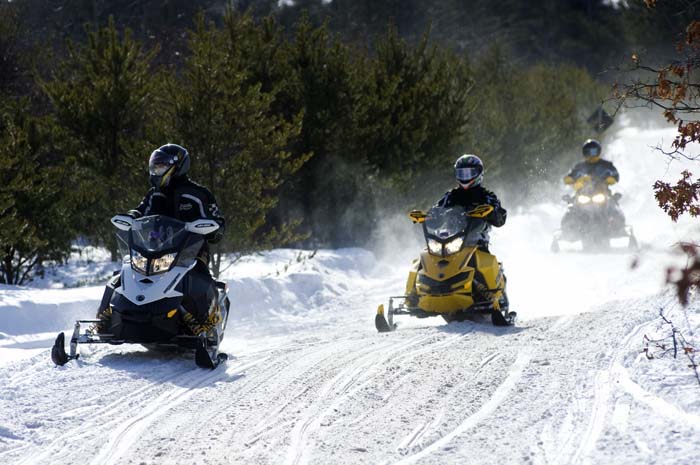 Snowmobiles in Action
Snowmobiles in ActionThe Upper Peninsula is laced with miles of trails for snowmobiles.
Many businesses along these trails, including restaurants and motels, cater to these folks who love to rush through the snow on their modern machines.
Others love to go skiing in the Porcupine Mountains or ice boating and ice fishing one of the many frozen lakes. One of the most beautiful lakes in the U.P. is Lake of the Clouds.
 Lake Superior in Winter
Lake Superior in WinterEven Green Bay freezes over and prevents shipping in the winter months. It's not inevitable these days, however, as the climate in the Upper Peninsula seems to be warming.
In the old days there were stage coaches that hauled people and freight on the thick ice from the Upper Peninsula 17 miles across the bay to Door County, Wisconsin.
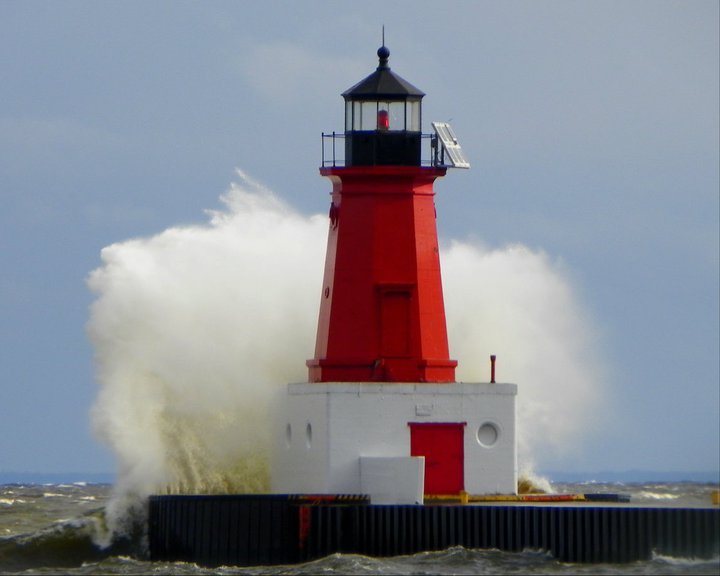 Menominee Lighthouse on Green Bay
Menominee Lighthouse on Green BayWhether it's summer, fall, or winter, another important part of Yooper culture is the neighborhood tavern. In the old days there seemed to be one on every block in every town in the U.P.
These taverns served as community centers, a place to relax after work, a place to take your family for a beer or a fish fry, or just a friendly place to get away from it all for awhile.
Many times the tavern reflected the ethnicity of the neighborhood. It might be French, Irish, German, Norwegian, Swedish, or many others.
The Upper Peninsula was a melting pot but people still enjoyed being around people from the Old Country.
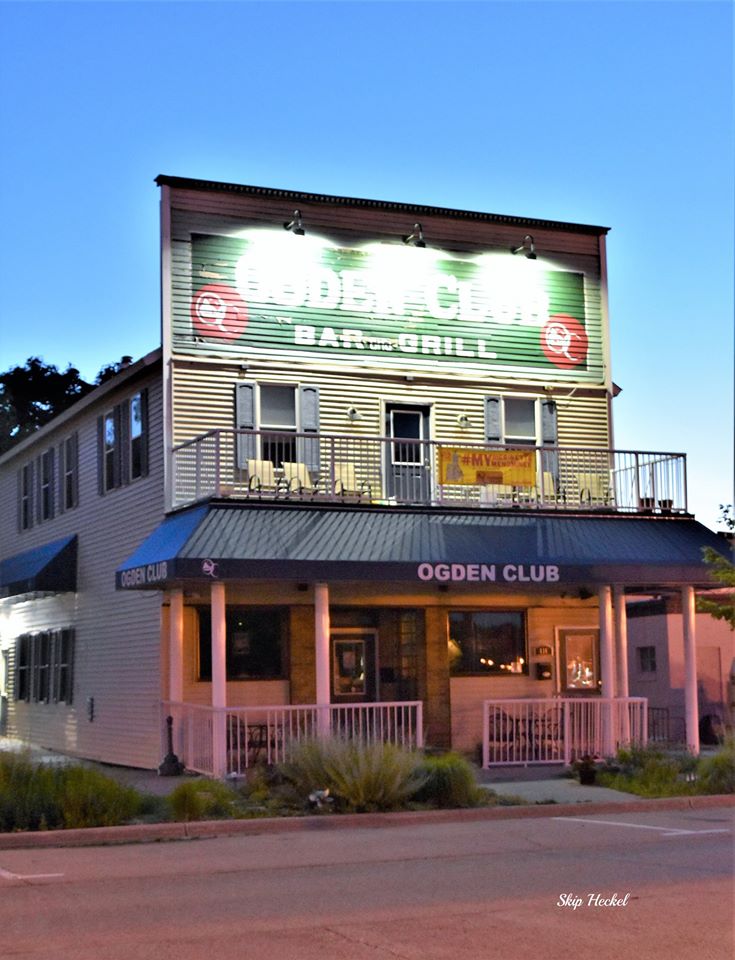 Ogden Club, Menominee, Michigan
Ogden Club, Menominee, MichiganWhen I lived in Menominee there were many neighborhood bars. The one closest to my house was the Ogden Club. Val was the owner and Alice was his hostess and waitress.
The Ogden Club is still there but under different ownership. The owners may have changed, but it's still a friendly neighborhood tavern.
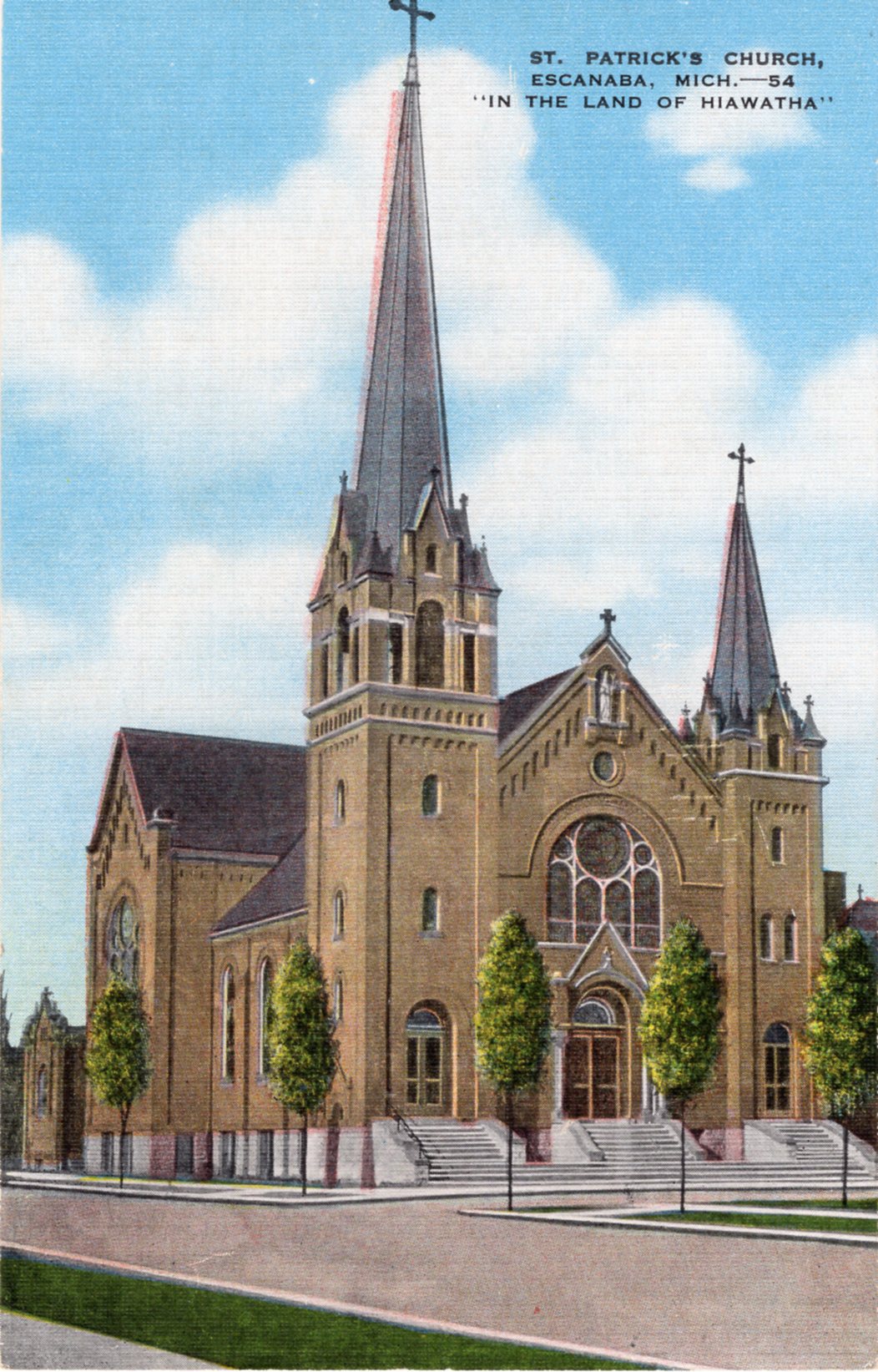
Just to be fair and balanced, it should be mentioned that churches were and still are a big part of the Yooper culture.
The large variety of different nationalities in the U.P. meant there is a church for almost any religion.
Many communities with large Polish and French populations had Catholic majorities.
But there were also plenty of Protestant denominations such as Lutheran, Methodist, and Baptist.
UPPER PENSINSULA EMPLOYMENT AND INDUSTRY
The major industries in the U.P. include manufacturing, technology, banking, business services, mining, construction, product distribution, warehousing, and healthcare. There is also a sizable number of people who work in government and education.
In spite of these jobs, the Upper Peninsula suffers from a much higher unemployment rate than the rest of the region, including downstate Michigan and Wisconsin.
This employment situation has been long term and is one reason why many Yoopers leave for the bigger cities down state or in adjacent Wisconsin or Minnesota.
But no matter where a Yooper man or woman may live now, the Upper Peninsula is still home in their hearts.
By Mike Miller, Copyright 2020-2025 YooperSecrets.com
